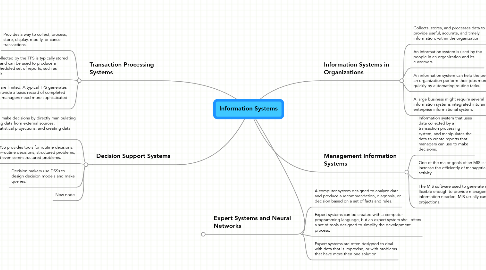Information Systems
by Andrew Galasso

1. Transaction Processing Systems
1.1. Provides a way to collect, process, store, display, modify, or cancel transactions.
1.2. The data collected by the TPS is typically stored databases, and can be used to produce a regularly scheduled set of reports, such as monthly bills.
1.3. Reporting capabilities are limited. A typical TPS generates detail reports, which provide a basic record of completed transactions. However, managers need more sophisticated reports.
2. Decision Support Systems
2.1. Helps people make decisions by directly manipulating data, analyzing data from external sources, generating statistical projections, and creating data models.
2.2. A DSS provides tools for routine decisions, non-routine decisions, structured problems, and even semi-structured problems.
2.3. Decision makers use DSSs to design decision models and make queries.
2.4. New node
3. Expert Systems and Neural Networks
3.1. A computer system designed to analyze data and produce a recommendation, diagnosis, or decision based on a set of facts and rules.
3.2. Expert systems can be created with a computer programming language, but an expert system shell offers a set of tools designed to simplify the development process.
3.3. Expert systems are often designed to deal with data that is imprecise, or with problems that have more then one solution.
4. Information Systems in Organizations
4.1. Collects, stores, and processes data to provide useful, accurate, and timely information, within the organization.
4.2. An information system is used by the people in an organization and its customers.
4.3. An information system can help the people in an organization perform their jobs more quickly by automating routine tasks.
4.4. A large business might require several information systems integrated into an enterprise informational system.
5. Management Information Systems
5.1. Information system that uses data collected by a transaction processing system, and manipulates the data to create reports that managers can use to make decisions.
5.2. One of the major goals of an MIS is to increase the efficiently of managerial activity.
5.3. The MIS software used to generate reports might not be flexible enough to provide managers with the exact information needed. MIS usually cannot create models or projections.


